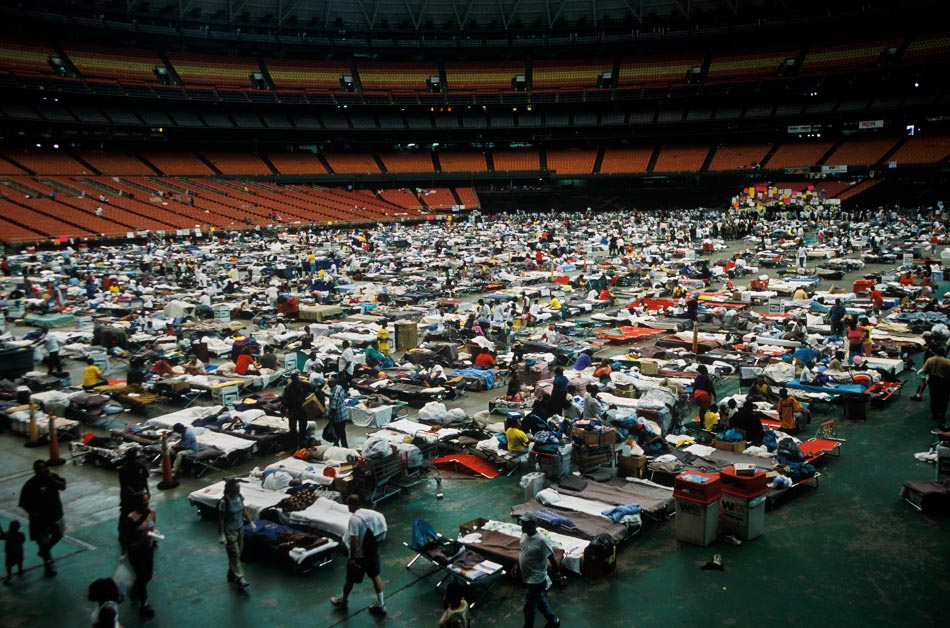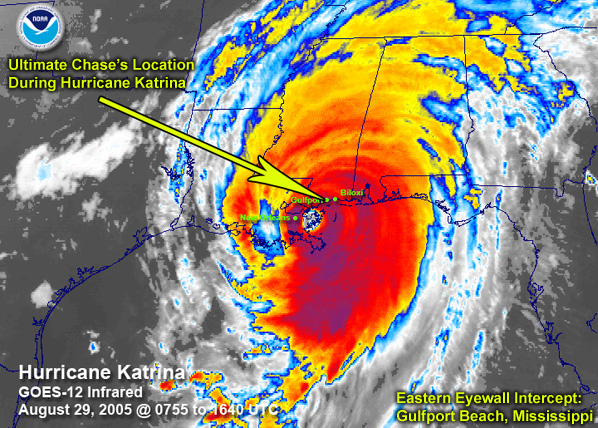Hurricane Katrina was a category 3 hurricane when it hit New Orleans, Louisiana on August 29th, 2005. The hurricane formed over the Bahamas, crossed over southern Florida as a category 1, and grew stronger when it crossed the Gulf of Mexico on its way to southeastern Louisiana. (source 1) Here is a map that shows the hurricane's path:

The key for a forming hurricane is warm ocean water. It provides energy for the hurricane and causes more evaporation causing humid air and clouds. With that, winds coming together force air upwards. Above the storm, winds flow outward allowing the air below to rise. The clouds of the storm are caused by rising, humid air. Light winds on the outside of the hurricane steer it and allow it to grow. (source 5)
An impact that hurricanes have on the environment is the dangerous floods they are known to cause. Hurricanes carry so much moisture that the clouds get full very fast causing long, powerful downpours of rain. Floods can lead to landslides as well. Not only does rain cause flooding, but the mound of water known as a storm surge that huron thricanes carry with them cause flooding along coastal lines. Another effect of hurricanes on the environment is on the bayous. High levels of bacteria get in the bayou and make the water unsafe to swim in. It’s bad for the fish and other animals in the bayou. Some fish even die from hurricanes because of the bacteria levels. It makes it hard for the fish and other animals to breathe. When people go fishing sometimes they get bad fish and when they eat them they can get very sick. (source 3)
Hurricane Katrina had a large impact on the economy. Insurance companies estimated $25 billion dollars in damage. And that is just the loss of property. While businesses are being rebuilt there is a large amount of lost revenue from not being able to prosper. Not to mention the loss of jobs from the companies that did not have insurance. According to "Financial Times" the total economic loss from Hurricane Katrina, was $100 billion. (source 2)
A hurricane watch is issued when hurricane conditions (sustained winds of 74mph or higher) are possible within a specified coastal area. A watch is issued 48 hours in advance of the anticipated onset of tropical-storm-force winds. A warning is issued 36 hours in advance of the anticipated onset of tropical-storm-force winds. A warning is given when hurricane conditions are expected somewhere within a specified coastal area. Watches and warnings are issued on all news channels. They are given out so early because hurricane preperation and preparedness is next to impossible to do while the conditions of a hurricane are present. (source 11)
Doppler Radars are used to look at a hurricane and predict its path. The radar sends beams of radiation. The shift not only in frequency, but also in carrier cycles, allows a scientist to determine the radial velocities. In order make this happen, the radar must be in a coherent state which allows for stabiltiy of the phases of the radiation pulses. (source 4)
Bibliography:
1) http://www.katrina.noaa.gov/. NOAA. Hurricane Katrina. NOAA Public Affairs. February 7th, 2007.
2) http://www.hurricanekatrina.com/suicide.org. HurricaneKatrina.com. Hurricane Katrina. Kevin Caruso. 2007.
3) http://www.nola.com/katrina/. NOLA. Hurricane Katrina. New Orleans Net LCC. 2011.
4) http://www.srh.noaa.gov/radar/radinfo/radinfo.html. National Weather Service Radar. WSR-88D, Radar. NOAA. March 3, 2005.
5) http://spaceplace.nasa.gov/hurricanes/. Hurricanes. NASA Official: Ruth Netting. May 5, 2011.
6) http://www.upi.com/News_Photos/gallery/Remembering-Hurricane-Katrina/3711/
7) http://www.google.com/imgresq=Hurricane+Katrina&hl=en&safe=strict&sa=G&gbv=2&biw=1024&trauma
8) http://www.katrinadestruction.com/images/v/houston.astrodome/14443-afterw.jpg.html
9) http://www.fema.gov/hazard/flood/recoverydata/katrina/katrina_about.shtm
10) http://www.ultimatechase.com/chase_accounts/hurricane_katrina.htm
11) http://mediamythalert.wordpress.com/category/hurricane-katrina/
12) http://www.nhc.noaa.gov/HAW2/english/forecast/warnings.shtml. NOAA. Severe Weather Watches and Warnings. NOAA Public Affairs. January 4, 2004.
Pictures/Maps:
 |
| (source 6) |
 |
| (source 7) |
 |
| (source 11) |
 |
| (source 1) |
 |
| (source 8) |
 |
| (source 9) |
 |
| (source 10) |
No comments:
Post a Comment